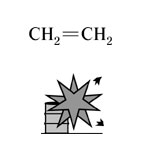| Case Name |
Fire due to inadequate finishing of an O- ring seal at a polyethylene manufacturing plant using a high-pressure method |
| Pictograph |

|
| Date |
October 13, 1973 |
| Place |
Niihama, Ehime, Japan |
| Location |
Chemical factory |
| Overview |
A large amount of ethylene gas etc., leaked from the flange near the outlet valve of the polymerization reactor at a polyethylene manufacturing plant one hour after the operation started, and an explosion occurred. At first, a small leakage occurred and it started burning because of an incorrect surface finishing of the flange of the O-ring seal of the outlet valve. The strength of the bolt decreased due to the heat of burning gas, and finally the bolt broke. A large amount of gas leaked and there was an explosion. |
| Incident |
An explosion occurred at a plant with a high-pressure polyethylene polymerization reactor one hour after start-up. The bolt which tightened the reactor outlet valve flange ruptured. A large amount of combustible gas leaked out, and an explosion occurred and a fire broke out. After the fire started, an emergency shutdown was carried out. |
| Processing |
Manufacture |
| Individual Process |
Maintenance |
| Chemical Reaction |
Polymerization |
| Substance |
Ethylene, Fig2 |
| Type of Accident |
Leakage, fire, explosion |
| Sequence |
On October 13th, 1973, about 11:30: Maintenance finished, and polymerization started.
12:25: About one hour passed, an explosion and a fire occurred near the outlet valve of a polyethylene polymerization reactor. After a fire started, an emergency shutdown was carried out. Gas remaining in the equipment burned for about four minutes.
12:33: The fire was perfectly extinguished about eight minutes after the fire started. |
| Cause |
There was a tightening bolt breakage at the outlet valve flange of the polymerization reactor, and a large amount of high-pressure un-reacted ethylene leaked. Prior to the bolt breakage, a small amount of gas was leaking and burning. The reason for the gas leakage was incorrect surface finishing of an O-ring seal portion. The main reason for this accident was considered that burning gas heated the tightening bolt and decreased its strength, leading to rupture. The time from start of fire until the bolt rupture was considered to be about 10-40 minutes. |
| Response |
After a fire broke out, an emergency shutdown was carried out. |
| Knowledge Comment |
The part of the outlet valve seal, where this fire accident occurred, is very important for leakage prevention. A sufficient construction check is necessary so that an incorrect surface finishing as in this accident will not occur. |
| Background |
The cause of the incorrect surface finishing of an O-ring seal was a technical problem of the engineer or the finishing condition was not checked (a problem of a supervisor). As polyethylene polymerization with a high-pressure method is performed at extra-high-pressure of 150-300 MPa, a leak test of the seal at the actual operation pressure before start-up is not practical. |
| Incidental Discussion |
The skill of the technician is a key point with such a surface finishing problem. A shortage of workers with good skill is a big problem at present. As the reaction section of a high-pressure polyethylene plant is dangerous, it is usually surrounded by a wall made of thick concrete. If a leakage occurs in the wall, it cannot be detected without a gas detector, as people do not enter inside the wall during operation. |
| Reason for Adding to DB |
Example of fire caused due to lower strength of a bolt from small fire of leaking gas |
| Scenario |
| Primary Scenario
|
Carelessness, Insufficient Precaution, Inadequate Handling, Poor Value Perception, Poor Safety Awareness, Inadequate Safety Countermeasure, Usage, Maintenance/Repair, Overhaul, Malfunction, Poor Hardware, Leak from O-ring, Failure, Fracture/Damage, Bolt Breakage, Secondary Damage, External Damage, Leakage/Explosion, Loss to Organization, Economic Loss, Dirct Monetary Damage 6 million yen
|
|
| Sources |
High Pressure Gas Safety Inst. of Japan: Niihama and Oita complex safety research report. pp. 50-51(1985).
|
| Financial Cost |
¥ 6 million. |
| Multimedia Files |
Fig2.Chemical formula
|
| Field |
Chemicals and Plants
|
| Author |
DOBASHI, Ritsu (School of Engineering, The University of Tokyo)
TAMURA, Masamitsu (Center for Risk Management and Safety Sciences, Yokohama National University)
|
|